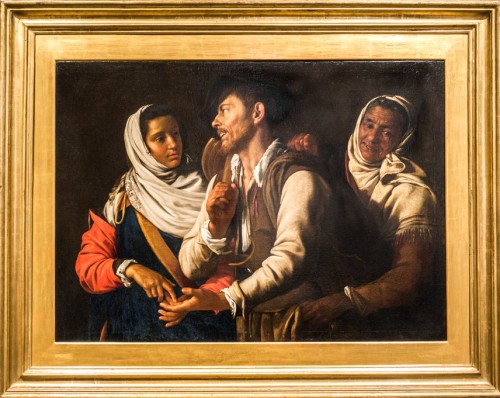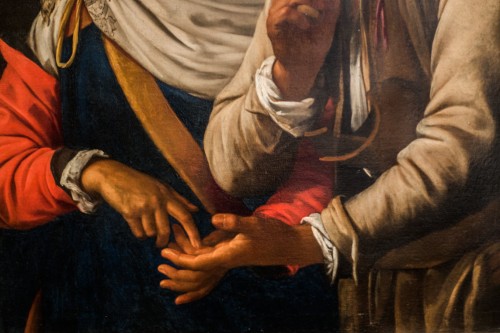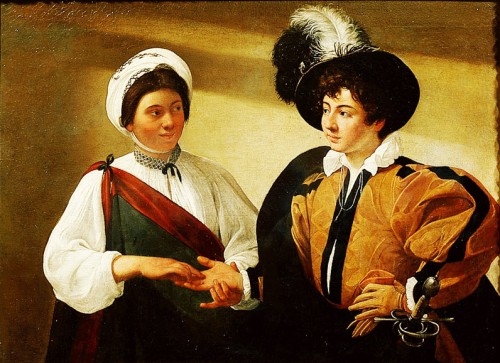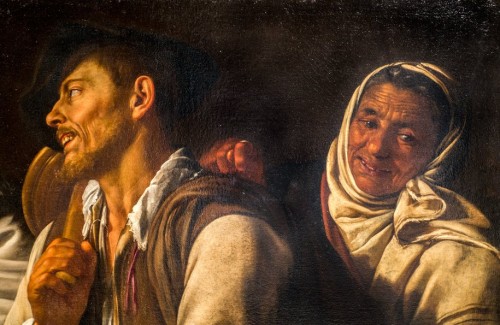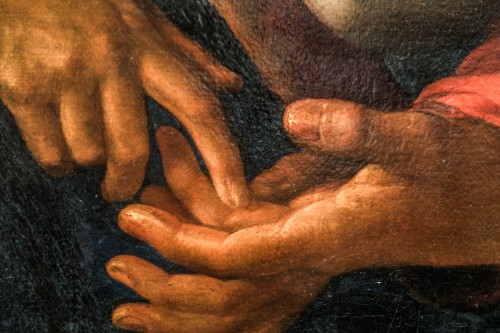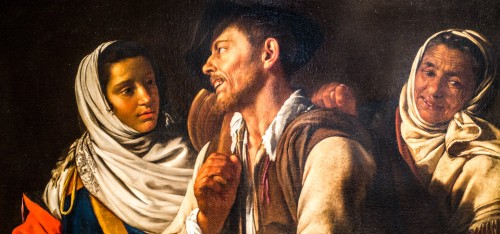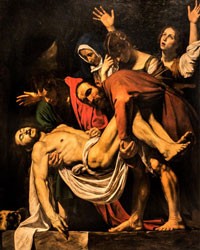And now let us imagine a young man, who has just arrived in Rome, perhaps a construction worker, looking for employment in the dynamically developing city. The man enters the city center and immediately catches the eye of two women. One of them, young and attractive stubbornly asks him to have his palm read, to show him the future awaiting in the new city. Her exotic beauty and persistence finally convince the youth – who perhaps only in fun stretches out his hand towards the Gypsy. The woman takes it in both hands and delicately touches his fingers, which brings a smile and slight disbelief to the eyes of the man – is it really about palm reading? Their eyes meet, the girl’s lips come slightly apart and at that very moment the Old Gypsy enters the scene, appearing behind the man’s back and taking advantage of his carelessness, she puts her hand into his pockets probably looking for his money pouch. At the same time, she looks at us” laughing right in our face”, making a rude gesture, as if she wanted to mock the young man who had just been duped. We are the involuntary witnesses to a theft, but also – in a way – the partners in crime of both women.

For a long time, the painting was attributed to various artists until it underwent conservation in 1996 – then on the reverse of the canvas an inscription appeared that was not visible before AEGIPITIA VULGO ZINGARA FATVI CERDONIS DIVINATRIX A SIMEO VOET AD VIVUM DEPICTA MCDXVII (“Egyptian commonly called gypsy telling the fortune of the foolish artisan, painted from the life by Simon Vouet 1617”). For any art historian such information is a real treasure revealing the surname of the author, the year the picture was painted, but also the painter's intention. Later the inscription goes on to inform that the work was dedicated to Cassino dal Pozzo – a Roman collector and scholar from Turin, who lived in the city on the Tiber and willingly surrounded himself with Frenchmen who had resided there. And it was he, who bought the painting from a young, very promising painter, who had come from Paris a few years prior, by the name of Simon Vouet.
In analyzing the motives of the artist who showed interest in such a topic, we come to the very interesting circle of the then-Roman collectors of art. The top among them was still Francesco del Monte and it was in his palace that the young Vouet had the opportunity (through Cassino dal Pozzo ) to become familiar with the painting The Fortune Teller by Caravaggio. In it, he saw a Gypsy woman and a young man and also had to see that delicate touch, which the man could not resist. When the Frenchman was studying the work, Merisi had already been dead for seven years, but his fame and work still fascinated young painters, who willingly took from his repertoire of topics, but also artistic means. They seized upon his tenebrism, limited palette of colors, but they took it in a new direction. One of the most skilled imitators of Caravaggio (the so-called Caravaggionists) was Bartolomeo Manfredi – the creator of only genre scenes taking place in the Roman brothels, taverns, and alleys – filled with drunk soldiers, gamblers, and prostitutes. Undoubtedly, the young, searching for interesting topics Vouet, fell under his influence.

Therefore, the works of Caravaggio and Manfredi, and perhaps also the suggestion of his client, influenced Vouet who desired to try his hand at the fashionable topic. Certainly, the aura of the Eternal City, with its dark alleys and exotic inhabitants was in itself intriguing for the twenty-six-year-old newcomer. Living in Rome, he could not avoid meeting the dark-eye, dark-skinned Gypsies, also known as Egyptians, since according to the knowledge available then, it was from Egypt that this ethnic group came. Perhaps, initially, he did not understand their game, ambiguous smiles, or even the gesture shown to us so unceremoniously by the old woman in his painting. In the meantime, he learned that this gesture can mean different things depending on the context and the situation. It is not only an expression of ridicule and mockery, frequently used in painting, for example in scenes ridiculing Christ on his way to Golgotha, but it also functions as a common, obscene symbol of intercourse. Interestingly enough, among the superstitious Roman populace, it was also a popular gesture that protected against all evil. The painter loved using this ambiguity. The old Gypsy can be a clever thief, mocking her victim, but also a bawd – a figure often present in the works of the then-Roman painters. An old, often toothless woman, with a wrinkled visage, often encourages young men to meet with her protégées and negotiates the prices for sexual services. This procedure had to make an impression on a freshly arrived stranger. The numerous brothels were open to a throng of clients with different tastes, and in taverns, one could encounter girls willing to be more than adventurous (for the right price of course), while procuresses were active in the better alehouses. The streets were also filled with them, where they waited for inexperienced youths. Perhaps one of the protagonists of this canvas is just such a woman. However, something else is visible in it – the attitude of Romans towards Gypsies, who were seen as liars, wanderers, or simply an inert mob without a place to live. It was also universally believed that they lacked morals and practiced prostitution and procurement. But the painting also reveals the very real fascination with their mysterious, chiromantic skills.
This time (as it would seem) an easy prey, in the form of the man presented in the painting, does not require the involvement of a procuress. But perhaps we are misjudging the woman, and her gesture is simply expressing her satisfaction with her thieving skills. The lack of a clear response only strengthens the emotional overtone of the painting – the scene is that which subconsciously "plays out" in the mind of the viewer.

What artistic means did Vouet use to introduce us to the atmosphere of the Roman milieu? Similarly to Caravaggio, he limited the color scheme. On a neutral, dark background, as if illuminated with an artificial, spotlight, the whiteness of the women's shawls and elements of the man's clothing stands out. The rest is kept in a homogenous, yet delicately varied gamma of browns and ochre. And even the sunburnt faces of the figures reflect in a lively manner in the whiteness of their clothes. Upon a closer look, we can feel the thickness, softness, and warmth of the women's woolen clothes, but also the coolness of the night, during which the scene takes place. And we will recognize the talent of the young painter, who despite sparing use of artistic means obtains a rich and varied color scheme in his work. He also introduces a bit of red into the painting – these are the external sleeves protecting from the cold. And it is this very element of the girl’s outfit that directs our gaze to the most important part of the painting – the moment of fascination born at the time of the delicate touch.
Vouet's painting has in it, a specific liveliness and directness. Is it, however, a genre scene, a spontaneously captured moment from the life of the Roman lower classes, as the inscription on the back of the canvas would suggest – ad vivum depicta? Yes, and no. The goal of the painter seems to be not so much the strive to most realistically present the scene, but more of a staging meant as a warning. This is a sort of instruction manual, a morality play, in which the gullible visitors are warned against the charms of a Gypsy and their own carelessness. Such "seductions" were a popular topic of humorous and burlesque anecdotes and the aforementioned theatre plays, while the painting itself, was later repainted three times by other artists, in almost an identical fashion.
There is yet another moralistic aspect of the painting – the passing of all things – vanitas – one of the most popular slogans of the Baroque. It is enough to take a look at both women – the face of the younger one is perfectly smooth and firm, while the face of the older – wrinkled and dry. One of them is just starting out in life, and the other is slowly, but with bravado, coming to the end of her road. The first does not yet know what life will bring – the second has no doubts, that one must do anything and everything to get ahead. Her only satisfaction remains the gesture of mockery directed at us.
The Fortune Teller (Buona ventura), Simon Vouet, 1617, oil on canvas, 95 cm x 135 cm, Galleria Nazionale d’Arte Antica, Palazzo Barberini
If you liked this article, you can help us continue to work by supporting the roma-nonpertutti portal concrete — by sharing newsletters and donating even small amounts. They will help us in our further work.
You can make one-time deposits to your account:
Barbara Kokoska
BIGBPLPW 62 1160 2202 0000 0002 3744 2108 or support on a regular basis with Patonite.pl (lower left corner)
Know that we appreciate it very much and thank You !

